Today Kawasaki finally pulled the wraps off its 2012 ZX-14R.
In 2008 Kawasaki implemented a number of tweaks and updates to the 14 aimed at improving low-end power, but the new model was given a head-to-toe going over for 2012. Although the land rocket of a sportbike retains a familiar look while gaining the R designation, below the surface the biggest of the Ninjas received its most comprehensive revision since its 2006 debut.
Headlining changes are a host of revisions for the big inline-Four powerplant, along with two firsts for the ZX-14: Kawasaki’s traction control system (KTRC) and a slipper clutch.
Engine Updates: More CCs to Please the Power Hungry
Leading off engine updates is a 4.0mm increase in stroke, from 61.0 to 65.0mm, while the 85mm bore remains unchanged. The ZX’s previous 1352cc was a class-leading displacement figure, but with the new 85.0mm x 65.0mm bore and stroke the 14 ensures its place as displacement king with 1441cc. Compression is also up, from 12.0:1 to 12.3:1.
Combustion chamber shapes were optimized for 2012, and they’re now surface-milled now rather than cast. Intake ports are reshaped and polished for improved flow, and new, longer intake valves have better durability, according to Kawasaki.
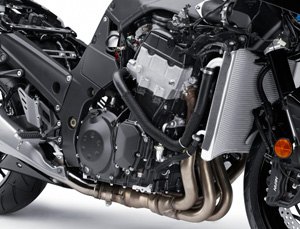 A thoroughly revised ZX-14 engine gets a bump in displacement, now 1441cc, as well as numerous upgrades and updates. Expect even more power than the previous ZX-14.
A thoroughly revised ZX-14 engine gets a bump in displacement, now 1441cc, as well as numerous upgrades and updates. Expect even more power than the previous ZX-14.Crankshaft main journals are thicker, from 38 to 40mm, and the engine’s dual gear-driven counter balancers have revised balance weights to help mitigate vibes in the longer-stroke engine.
A new air-cleaner element is larger and thicker, with 10% more surface area and 40% more airflow capability, allowing better breathing for the revised fuel injection system. The exhaust system is essentially all-new with reshaped, larger-diameter tapered header pipes, and larger-volume, reshaped mufflers each house a catalyzer.
Manufacturers aren’t always willing to divulge horsepower ratings, and this time is no different, but we can safely speculate crankshaft power above 200 ponies. The previous model claimed 190 hp at the crank with peak torqe at 113.5 ft-lbs at 7500 rpm. The last time Motorcycle.com dyno tested the 14, the big ZX produced 159.5 hp at 9550 rpm and 99 ft-lbs at 7800 rpm.
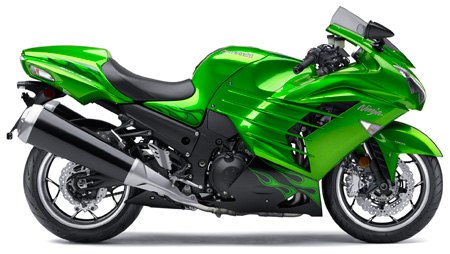 Here you can see the revised main fairing’s increased venting. An all-new exhaust system is also part of the revamp. Here you can see the revised main fairing’s increased venting. An all-new exhaust system is also part of the revamp. |
Kawasaki says the myriad changes and updates to its biggest sportbike engine have led to more power at nearly every point in the rev range, claiming stronger acceleration from 4000 rpm onward.
For the ZX-14’s U.S. launch in 2006, and its mid-cycle model revision in 2008, Kawasaki purposely selected drag strip testing as part of the program for the moto media to experience the big Ninja’s power. During each of those events Motorcycle.com editors came away impressed with the strength and durability of the ZX’s clutch, as it endured hard launch after hard launch down the quarter-mile. So while no one questioned the 14’s clutch performance over the years Kawasaki nevertheless improved upon a good thing, and included a race-derived slipper clutch as part of the bike’s overhaul for 2012.
Additionally, to cope with the engine’s newfound power, transmission gears have been heat- and surface-treated for improved durability and smoother shifting action.
Frame and Chassis Updates
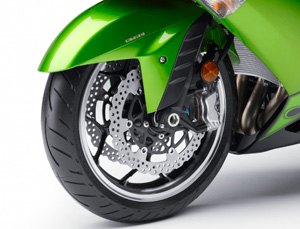 New 10-spoke wheels are a total of 3.3 pounds lighter than last year’s wheels. New brake discs are said to improve feel at the brake lever.
New 10-spoke wheels are a total of 3.3 pounds lighter than last year’s wheels. New brake discs are said to improve feel at the brake lever.The Ninja’s 43mm inverted fork with 13-way compression damping adjustment and 11-way rebound damping, as well as the fully adjustable shock, have revised internal settings and are said to better resist bottoming. Spinning at each end of this super sled are all-new 10-spoke machined aluminum wheels that Kawasaki says are a total of 3.3 pounds lighter than the previous wheel set. Attached to the new wheels are reshaped petal-type brake discs made from a more rigid material. The new discs along with new brake pad material are said to increase feel at the lever.
Despite the useful weight loss in the wheels, the new ZX-14R’s claimed curb weight is now 584 pounds, up from the previous bike’s nearly 567 pounds. This follows an increase in dry weight in 2008 when the ZX-14 gained 11 pounds (a result of the then new exhaust system) from the 2006 model’s dry weight of 474 pounds.
New Bodywork: Subtle but Tougher Looking
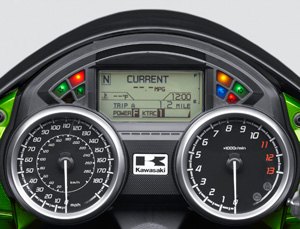 New instrument cluster includes displays for KTRC and power mode selection. Analog dials for the speedo and tach nicely balance the gauge package.
New instrument cluster includes displays for KTRC and power mode selection. Analog dials for the speedo and tach nicely balance the gauge package. The frontal area of the fairing has a more aggressive nose design and the quad-headlight glass assembly is now reshaped so as to create the look of two separate lights rather than four on the previous 14. The traditional 4-fin theme along the fairing’s sides has a more pronounced 3D design this year, which Kawi says better vents engine heat away from the rider and passenger. Designers also took pains to conceal as much as possible body panel fasteners and hooks.
Faired-in turn signals remain part of the bodywork, as does a pillion cover – standard on all U.S.-spec models – but a newly shaped seat is claimed to offer better support while making it easier for shorter riders to reach the ground. However, the 31.5-inch seat height remains the same.
KTRC: Power Modes with Traction Control for the New ZX-14R
Perhaps the biggest update to the new 14 other than engine changes is the inclusion of KTRC, Kawasaki’s proprietary switchable engine mapping and traction control system.
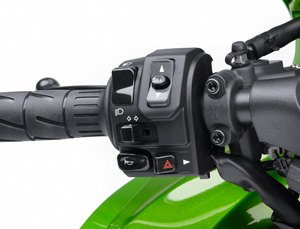 New switchgear contains toggle switch with integrated selector button. This toggle/switch handles many functions, including controlling KTRC.
New switchgear contains toggle switch with integrated selector button. This toggle/switch handles many functions, including controlling KTRC.Despite inclusion of KTRC, ABS is still not part of the repertoire of the ZX’s safety features.
The new ZX-14’s instruments and controls have been reworked as well, with a newly finished gauge cluster and a new multi-function switch on the left handlebar that handles all system functions.
Colors for the 2012 ZX-14R are Metallic Spark Black, Candy Surf Blue or Golden Blazed Green with special graphics (SE). Pricing is currently set at $14,699, an $1100 increase from 2011.
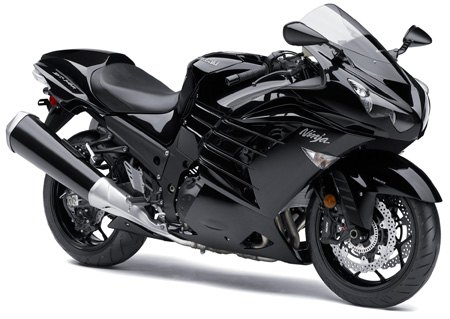 The new ZX-14R continues to push the boundaries of big, fast sportbikes.
The new ZX-14R continues to push the boundaries of big, fast sportbikes.


 8:28 AM
8:28 AM
 Unknown
Unknown


 Posted in:
Posted in: 




0 comments:
Post a Comment